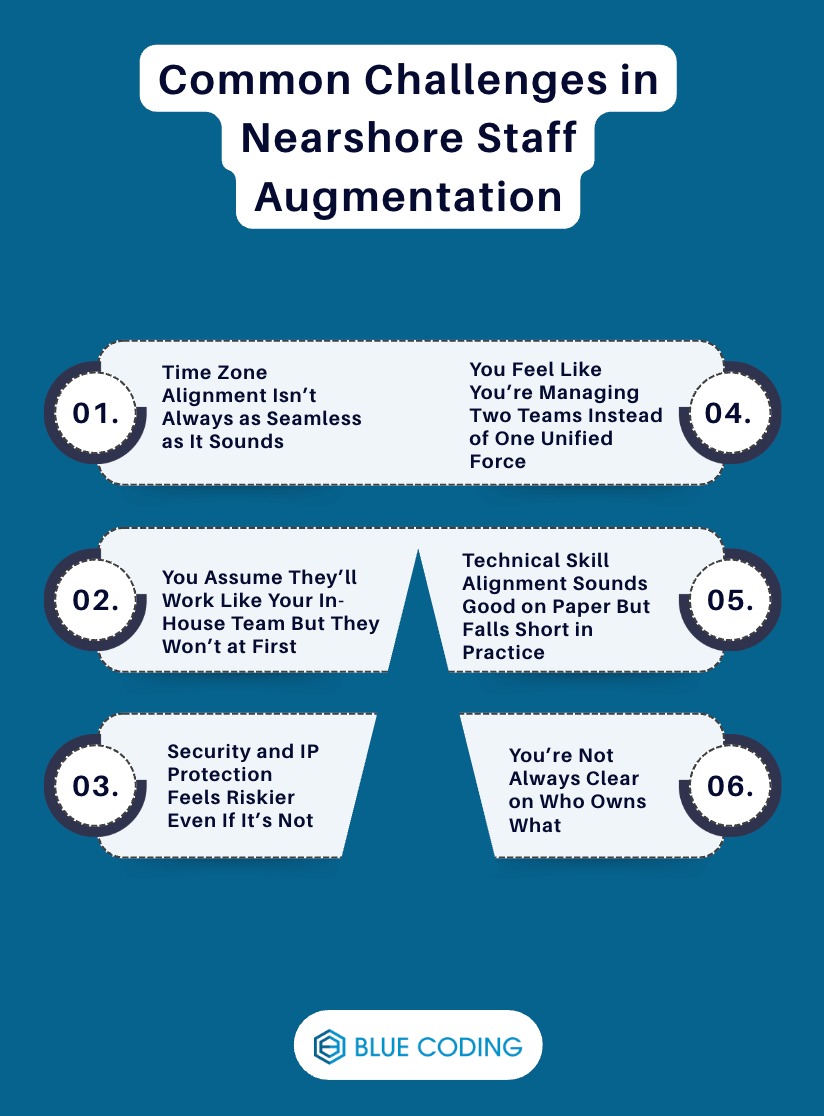 News
News
The first quarter of the year always brings a few team adjustments, whether that means upsizing, downsizing, or even just rightsizing as a company-wide move. Now, if you need to grow your software development and IT department, one of the best options to consider when it comes to expanding an organization’s workforce is nearshore staff augmentation. With the IT staffing market expected to grow to USD 43.68 billion by 2027, it’s only normal for companies to start looking into alternative recruitment methods to save money on development costs and get a better bang for their buck. Even if it isn’t the right time for your company to try IT staffing, it’s better to be informed and ahead of the game. That’s why in this article, we’ll discuss what nearshore staff augmentation is, its different benefits, and how you could get started today.
First, what is staff augmentation?
Staff augmentation is a process that consists of the strategic hiring of IT professionals from outside of your company to fill in temporary roles, provide additional expertise and resources, access a larger and more diverse workforce, or hire developers at a lower cost. This can provide organizations with access to a larger amount of IT professionals with new skill sets that may not be available within their existing team, as well as provide them with the flexibility to scale up or down their workforce as needed without requiring them to resort to temporary hiring.
Then what is nearshore staff augmentation?
Nearshore staff augmentation is an IT outsourcing strategy that involves hiring a remote team of professionals from a nearby country or region to add to your already working in-house staff. By outsourcing certain tasks or projects to nearshore development specialists from areas such as Latin America, North American organizations can save a substantial amount of money while simultaneously gaining access to specialized talent and improved development results.
Unlike offshoring, the key differentiator of nearshore staff augmentation is that this practice consists of adding outsourced staff from a physically nearby location. Offshore staff augmentation, on the other hand, involves hiring IT professionals from faraway areas such as Eastern Europe and India. This usually means companies have to deal with added language barriers, cultural differences, and time zone complications - though the costs can be even cheaper.
What is a nearshore software development company?
If you’re looking to get started with nearshore staff augmentation as a traditional hiring alternative for your business, then you should consider partnering with a nearshore software development company. This type of IT staffing agency is an organization that specializes in providing software outsourcing services from nearshore locations close to the headquarters of the hiring companies. A nearshore software development company can provide cost-effective ways to hire software developers in Latin America thanks to the way they take charge of the entire outsourcing process, including researching and vetting potential hires, interviewing candidates, assessing their technical skills, hiring and onboarding, and even paying your new outsourced developers.
What are the benefits of nearshore staff augmentation?
A sizable cost reduction.
There’s no denying that hiring developers in North America has become increasingly expensive over the years. From the overall talent crunch - the talent shortage could create 85 million unfilled jobs according to a Korn Ferry study - and the specific IT talent shortage that saw its beginnings with the Great Resignation to the extensive US inflation of recent years, developers have now become both more difficult to find and more expensive to hire. On the other hand, nearshore staff augmentation allows companies to hire LATAM developers for rates that are between 30-50% lower. This saves a significant amount of money on development costs and allows organizations to reallocate those monetary resources better.
Minimal time zone differences and cultural barriers.
As we’ve mentioned before, nearshore staff augmentation offers quite a different set of advantages compared to the other outsourcing option of offshore staffing. With nearshore outsourcing, companies located in North America can hire Latin American developers and still have both their in-house staff and outsourced development team work within the same hours. Additionally, developers located in nearshore countries often share similar values, beliefs, and cultures with their customers, which can make it easier for in-house and outsourced teams to work together on international projects and better understand each other’s needs.
Larger talent pools to choose from.
The US IT talent shortage is no secret, and with the past 2022 tech market crash, not every company can afford to pay the increasingly higher rates that IT professionals within North America ask for. Between the costs and the little variety to choose from, expanding to nearshore locations and interviewing LATAM developers can prove to be the best solution to this hiring issue. As Latin America is such a large region filled with multiple IT-oriented countries that host thousands of qualified nearshore developers, the talent pool for those hiring from this region immediately becomes larger. Whether you want to hire developers in Mexico, Argentina, or Brazil, there are bound to be IT candidates ready to deploy.
Faster recruitment procedures.
Traditional recruitment takes time, especially when it comes to technical hiring. Finding skilled developers and assessing their knowledge and command of different tech stacks can get challenging, even more so if your team is conducting remote interviews. Luckily, nearshore staff augmentation usually involves hiring a nearshore software development company to outsource developers for you. The team from the IT staffing agency then handles the entire IT recruiting process and only asks for your help approving the final candidate/s. This helps your company save both time and resources and allows you and the rest of your in-house team to focus on their regular tasks instead of the additional workload of hiring new developers.
Increased work efficiency.
Finally, nearshore staff augmentation leads to increased productivity and work efficiency. This is thanks to the way remote work offers flexible work conditions to software developers and allows them to perform all tasks more efficiently and without wasting time on a regular commute. In fact, statistics show that remote workers display 4% higher productivity levels than their office-going counterparts. Moreover, hiring with the help of an agency providing nearshore software development services grants your company access to developers ready to deploy. This allows your team to start working on different IT projects faster and minimizes waiting times between development sprints.
When Should You Choose Staff Augmentation?
Understanding the right time to leverage staff augmentation is essential for getting the most out of this flexible hiring strategy. Here are several key situations where it can bring real value to your organization:
1. Managing Short-Term Projects:
If you’re tackling a time-sensitive project with a clear deadline, staff augmentation is a smart way to bring in qualified professionals fast. It lets you address immediate technical needs without overloading your in-house team or committing to long-term contracts.
2. Addressing Skill Shortages:
When your internal team lacks niche expertise—say in blockchain, AI, or cybersecurity—staffing services can fill those gaps efficiently. Instead of hiring full-time employees for specialized roles, you can bring in top-tier talent temporarily to fill those critical knowledge gaps.
3. Rapid Business Growth:
If your business is growing quickly, scaling your team through staff augmentation is a flexible, fast-track option. This approach is especially valuable for startups and tech companies needing to ramp up quickly without lengthy hiring processes. Upwork found that nearly 60% of businesses are now using flexible staffing to navigate shifting market conditions.
4. Coping with Seasonal Spikes:
For companies facing periodic increases in workload - like during holiday seasons or product launches - staff augmentation provides a cost-effective way to scale up temporarily. You get the extra hands you need without committing to long-term hires for short-term needs.
5. Refocusing on Core Operations:
When internal resources are stretched too thin across multiple initiatives, it’s time to consider augmenting your staff. Delegating non-core tasks to an outsourced team allows your internal employees to concentrate on high-impact, strategic work that drives long-term success.
6. Accelerating Deployment:
Speed is critical in competitive markets. Staff augmentation empowers you to onboard skilled professionals quickly, helping you maintain momentum on key projects. Whether you're launching a new product or integrating new systems, rapid deployment keeps you ahead of the curve.

Common Challenges in Nearshore Staff Augmentation and How to Overcome Them

Time Zone Alignment Isn’t Always as Seamless as It Sounds 》
Nearshore teams are supposed to solve time zone friction but it’s not always a perfect fit. Sure, the hours overlap better than offshore models, but even a few-hour difference can throw off meeting schedules or delay same-day turnarounds. What’s the fix? Set core collaboration hours from day one. Define what “real-time” actually means for your team and use async-friendly tools (like Loom or Slack standups) to keep momentum going when clocks don’t sync perfectly.
You Assume They’ll Work Like Your In-House Team But They Won’t at First 》
One of the biggest mistakes is expecting nearshore developers to instantly gel with your internal culture and workflows. They’re technically your team, but they’re still coming from different company cultures and communication norms. The solution is easy, treat onboarding like a two-way street. Share your internal playbooks, assign a cultural buddy from your team, and invest a little extra time upfront in getting alignment on work style, not just tech stacks.
Security and IP Protection Feels Riskier Even If It’s Not 》
Trusting external partners with sensitive data or proprietary code can make any founder nervous. And rightly so. But proximity doesn’t automatically equal security. The answer isn’t avoidance, it’s formalization. Use robust NDAs, data access policies, and compliance frameworks. Choose partners with a proven track record in IP protection, and ask the hard questions about how they manage secure environments before any code is written.
You Feel Like You’re Managing Two Teams Instead of One Unified Force 》
This one’s subtle but it hits hard. When nearshore teams feel separate, culturally, communicatively, or operationally, you lose that seamless collaboration flow. People start working in silos, and suddenly you’re managing “us” and “them.” The way out is to simply over communicate. Run joint retros, share company wins in a shared Slack channel, and make your nearshore devs part of your everyday rituals. Culture isn’t built in meetings, it’s built in the in-between moments.
Technical Skill Alignment Sounds Good on Paper But Falls Short in Practice 》
Let’s say you hire a nearshore backend dev with years of Node.js experience. Great. But then they struggle to adapt to your team’s coding standards, review cycles, or infrastructure tools. Why? Because skill matches aren't the same as team fit. To overcome this, go beyond the résumé. Run technical pairing sessions during the hiring phase, test for problem-solving in your environment, and prioritize adaptability over just checkboxes on a tech stack list.
You’re Not Always Clear on Who Owns What 》
Shared accountability across time zones can get messy fast. Are they just executing tasks, or are they owning deliverables? If there’s no clarity, you risk duplicated work, missed deadlines, or finger-pointing. The fix is to define ownership roles with intention. Create swimlanes that outline responsibilities, escalation paths, and decision-making power. If your nearshore partner feels empowered and accountable, that’s when real collaboration happens.
Ready to try nearshore staff augmentation with an experienced agency?
For those companies looking to benefit from cost savings and other benefits, Latin America is an attractive option due to its proximity and strong talent pool. At Blue Coding, we’re well aware of the many different benefits of nearshore staff augmentation. As a nearshore software development company, our team has years of experience using staff augmentation strategies to help companies from all over the world hire developers in Latin America and other regions. We handle every step of the process, from vetting and interviewing to billing and check-ins to ensure smooth recruitment. Contact us today to learn more about our nearshore software development services!



